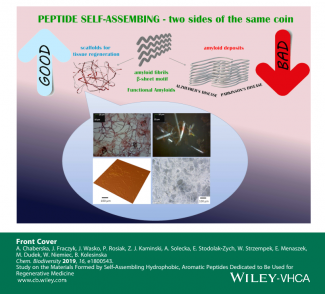The groundwork for the project Innovative hybrid materials for wound dressings in the treatment of diabetic foot is directly related to my research interests in natural compounds, including peptides. I started from looking for minute fragments of proteins that enable their aggregation, which ultimately leads to the formation of insoluble deposits known as amyloids. I have focused on investigating two hormones regulating carbohydrate metabolism, i.e. insulin and amylin. Both these polypeptides tend to aggregate, which is associated with the development of type II diabetes. While searching for minimal fragments of hormones responsible for the aggregation, it occurred to me to further explore the topic in order to try and find an answer to the question whether the properties of amyloids (resistance to proteolytic enzymes, conformational stability, very good mechanical properties, in terms of new materials) could be used to develop new materials. In other words, could it be that short, amyloid-type peptides are two-faced, sort of like " Dr. Jekyll & Mr. Hyde "?
These three characteristics of amyloid deposits provided a baseline for the study of peptides as compounds forming multidimensional materials, which in turn spawned research into their application as scaffolds in regenerative medicine. Peptides provide for full biocompatibility because our organisms are built of proteins.
Prior research
However, the mechanical properties of peptide materials come short of meeting all of the expectations set for materials for regenerative medicine. Hence, an idea was floated to introduce polysaccharides to achieve the desired mechanical properties. Combining the properties of polysaccharides and peptides should enable production of materials with adequate mechanical (polysaccharides) and biological properties (peptides, synthetic protein fragments). This hypothesis was put to the test as part of the already completed OPUS 10 project Innovative hybrid materials for tissue regeneration derived solely from natural compounds which was carried out by two research groups from Lodz University of Technology: the Institute of Organic Chemistry, Faculty of Chemistry, and the Institute of Materials Science of Textile and Polymer Composites, Faculty of Materials Technology and Textile Design, as well as from the AGH University of Science and Technology and Jagiellonian University.
The project allowed us to confirm the hypothesis that hybrid polysaccharide-peptide materials provide for improved functional properties compared to single-component materials. On the other hand, it showed that the single peptide approach should be replaced with a more holistic treatment of the problem of regeneration as, in the living organism, it is a very complex process involving a huge number of natural compounds of different structure.
From there came the idea to try and develop materials which could be used in the treatment of hard-to-heal wounds.
Materials and a standardized approach to chronic wound treatment
The aim of the study is to design, synthesize, and test the properties of new, multi-component hybrid materials effective in hard-to-heal wounds, including in diabetic foot syndrome. The resultant hybrid materials will provide the basis for proposing a holistic instrument for the treatment of tissue loss. The achieved multi-component materials should meet all the criteria for the standardized management of chronic wounds - TIME strategy (Tissue debridement, Infection/inflammation control, Moisture balance, Epithelial edge advancement). The aim of the project we are currently working on is to restore optimal biochemical, physical, and microbiological conditions by removing barriers, remedying disorders affecting lack of healing, and enhancing the capacity for natural wound healing processes.
We expect that as a result of the synergy between the selected set of biologically active peptides and polysaccharides it will be possible to produce a new generation of materials which will have an effect on haemostasis, inflammation, tissue proliferation, and re-modelling. The materials will have an appropriate three-dimensional structure, mechanical strength, flexibility, and will allow for producing an effect during each individual stage of the wound healing process.
Interdisciplinary research
The project Innovative hybrid materials for wound-dressings in the treatment of diabetic foot is carried out by a consortium consisting of Lodz University of Technology, Medical University of Lodz, and the Łukasiewicz Research Network - Textile Research Institute.
The research on protein fragments which have an influence on, i. a.: haemostasis, tissue proliferation and remodeling, and inhibition of inflammation development is carried out concurrently. The selection of a set of biologically active peptides is performed with the SPOT method, which allows for simultaneous synthesis of fragments of proteins involved in the healing process. Such a procedure should enable the study of a considerable set of proteins involved in the healing process, and thus, the selection of biologically active peptides derived from these proteins.
Who will benefit from the dressings?
Most frequently, hard-to-heal wounds develop on the lower limbs. They are vascular wounds (venous leg ulcers, ischemic ulcers in atherosclerosis, and mixed venous-ischemic ulcers), diabetic foot syndrome, and trophic ulcers ( pressure sores). Others include immunological, haematological wounds, wounds in purulent gangrenous dermatitis, neoplastic ulcers, and wounds accompanying congenital vascular malformations. The group of patients requiring specialized dressings is considerable. The problem of diabetes may concern as many as 3 million people in Poland. Diabetic foot syndrome is one of the most common causes of hospitalization as far as complications from diabetes are concerned and affects about 4-10% of patients. The probability of ulceration in diabetics ranges from 12 to 25% and is, at the same time, the most common non-traumatic cause of amputation within the lower limbs. The risk of limb loss in the population of people with diabetes mellitus compared to the general population is even 30-40 times higher. It is estimated that about 20% of hospitalizations for amputation are performed on patients with diagnosed diabetes, with peripheral circulation complications.
When will the materials be available for patients?
The project has been running since July 2019, therefore it is still too soon to say when it will be possible to make the materials available to patients. It should also be borne in mind that this is a project which involves fundamental research, and there is still a long way to go before the actual dressing material is released to the patient





